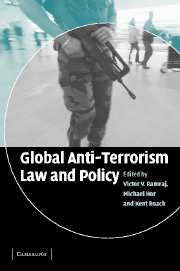Book contents
- Frontmatter
- Contents
- List of contributors
- Acknowledgements
- 1 Introduction
- PART ONE Theoretical Perspectives on Anti-Terrorism Law and Policy
- 2 Terrorism and the counter-terrorist discourse
- 3 The question of a generic definition of terrorism under general international law
- 4 The state of emergency in legal theory
- 5 Stability and flexibility: a Dicey business
- 6 Terrorism, risk perception and judicial review
- PART TWO A Comparative Study of Anti-Terrorism Measures
- PART THREE Anti-Terrorism Law and Policy in Asia
- PART FOUR Regional Cooperation
- PART FIVE Anti-Terrorism Law and Policy in the West
- PART SIX Anti-Terrorism Measures in Africa, the Middle East and Argentina
- Index
2 - Terrorism and the counter-terrorist discourse
Published online by Cambridge University Press: 21 July 2009
- Frontmatter
- Contents
- List of contributors
- Acknowledgements
- 1 Introduction
- PART ONE Theoretical Perspectives on Anti-Terrorism Law and Policy
- 2 Terrorism and the counter-terrorist discourse
- 3 The question of a generic definition of terrorism under general international law
- 4 The state of emergency in legal theory
- 5 Stability and flexibility: a Dicey business
- 6 Terrorism, risk perception and judicial review
- PART TWO A Comparative Study of Anti-Terrorism Measures
- PART THREE Anti-Terrorism Law and Policy in Asia
- PART FOUR Regional Cooperation
- PART FIVE Anti-Terrorism Law and Policy in the West
- PART SIX Anti-Terrorism Measures in Africa, the Middle East and Argentina
- Index
Summary
Introduction
Nearly every essay on the subject of terrorism makes an apologetic nod to the difficulties of defining the term. Despite frequent mentions of ‘state terrorism’ as a form of many types of terrorisms, relatively few works then go on to discuss state terror, and those that do treat it as independent of non-state terror, state-sponsored terror or counter-terrorist policy. This chapter in some sense is little different, in that it too addresses definitional considerations. It departs from other works, however, in important ways. It adopts a Weberian mode of definition: that is, the elements discussed that constitute what is meant by ‘counter-terrorism’ or ‘terrorism’ are included not because I claim to have reached any great truth or resolved a discussion that is centuries old, but rather because I am writing about liberal, democratic states’ response to what they perceive to be terrorist challenge. Thus, while I take Annamarie Oliverio's point well, that to have amassed a number of definitions and isolated common elements – as though truth were dependent on a majoritarian decision – distorts academic inquiry, I nevertheless find it helpful to describe the rules by which certain types of challenge become categorized. My contention is that once a challenge to a liberal, democratic state has been labelled as ‘terrorist’, certain responses follow. My purpose is to point out the associated risks.
- Type
- Chapter
- Information
- Global Anti-Terrorism Law and Policy , pp. 13 - 36Publisher: Cambridge University PressPrint publication year: 2005
- 1
- Cited by



